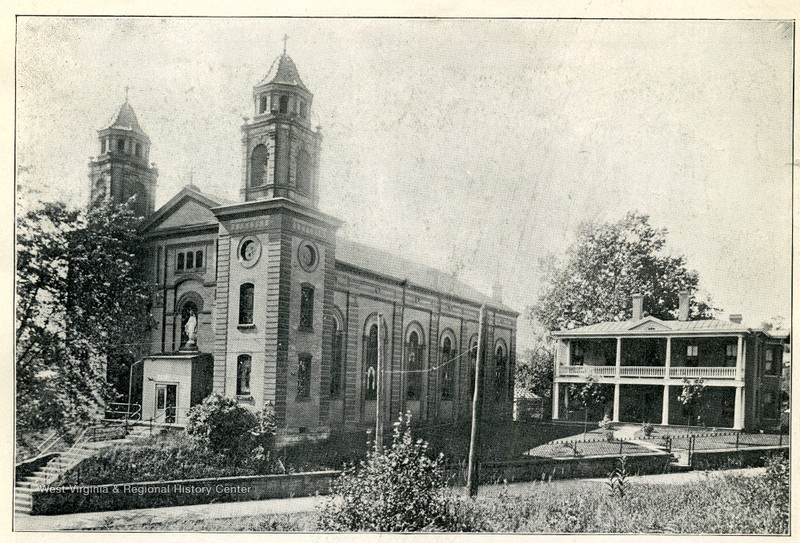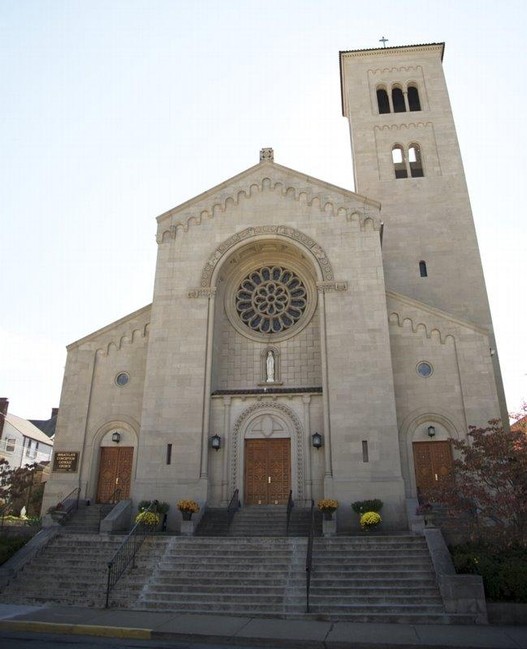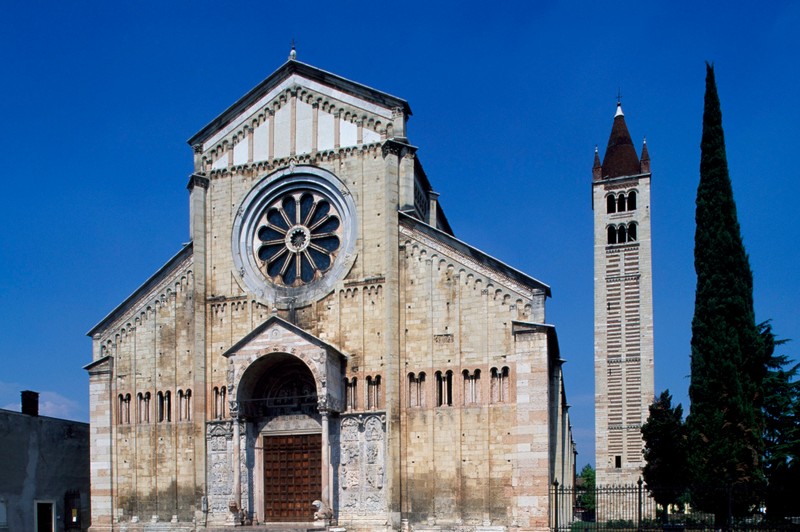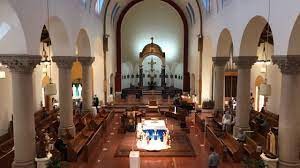Immaculate Conception Church
Introduction
Text-to-speech Audio
Images
The original Immaculate Conception Church, which stood from 1865 until the early 1920s.

The Immaculate Conception Church.

The Church of San Zeno, which heavily inspired the Immaculate Conception Church.

The interior maintains basilican features. The ciborium is also visible above the altar.

Backstory and Context
Text-to-speech Audio
The first record of a Catholic population in Clarksburg appeared in 1856. Irish immigrants escaping the Great Famine were hired to work on the westward expansion of railroads between Baltimore and Ohio. Already largely inclined towards the Catholic faith, these immigrants were particularly devout, as they brought nothing with them and the need for community was strong. For several years, Clarksburg’s Catholic population was religiously serviced by intermittently travelling priests, who came from places as far flung as Brownsville, Pennsylvania; Cumberland, Maryland; and Weston, West Virginia. As the Clarksburg congregation continued to grow, priests from Weston visited monthly to conduct services in private homes. Seeing the need for a more permanent solution, Clarksburg was granted its own parish in 1864. Father Daniel O’Connor, previously the priest at Weston, was appointed pastor in the new parish.
One of Father O’Connor’s first projects in Clarksburg was the establishment of a permanent place of worship. With the help of the Diocese of Wheeling, he purchased a fair amount of land from Major James Jackson. The land was on the east side of Elk Creek, and the modern day intersection of Pike Street and Sandy Boulevard was chosen for the place of worship itself. Despite the impoverished nature and small size of the congregation, $12,000 dollars were raised in short order to fund construction. This feat is especially impressive when one considers that the fundraising also occurred during the final stages of the Civil War. The church was built primarily of brick — two hundred thousand of them were directly made on the property. Construction continued through 1865. On August 5th, roughly one year after the Clarksburg parish was established, the church was completed and officially dedicated to the Virgin Mary. The relatively large building was classical in style with heavy Italian influence. It featured a simple axial plan, though no clerestory, only a gabled roof.
Though the original Immaculate Conception Church served the Clarksburg congregation well for many years, by the 1920s, it was no longer adequate. The old building was demolished and a new enormous Italian Romanesque structure took its place. E.J. Weber, a noted Pittsburgh architect of Catholic churches, was contracted to design the Immaculate Conception Church building. Weber drew from Italian churches to plan the current Immaculate Conception Church. The architect specifically cited the Church of San Zeno in Verona, Italy as one his most important influences for the Immaculate Conception Church. This influence can be seen in the general shape of the facade, as well as in the recessed campanile on the right side, though Weber’s campanile is attached while San Zeno’s is detached. With the exception of St. Joseph Cathedral in Wheeling, the Immaculate Conception building is the largest and most spectacular Catholic church in West Virginia. The building’s significance is underlined by its inclusion in the March 1926 issue of The Architect. The Architect was a New York City based nationwide scholarly architectural publication that included only “the best work being produced in America.”1 That the Immaculate Conception Church was chosen for inclusion is testament to the design and physical craftsmanship on display.
The Immaculate Conception Church draws heavily from a previously established canon of church architecture. The triangles and clean lines of the front facade recall the geometric architectural forms of the Renaissance. A deeply recessed entry arch bounds a rose window and is capped by a bracketed cornice. A huge campanile — or bell tower — is set to the right and slightly back from the facade. Despite its auxiliary location, the campanile looms over the church and its surroundings. The interior of the building maintains basilican parallels seen on the exterior. Smooth Romanesque columns support an unornamented barrel vault. The focal point of the nave ends at a freestanding marble ciborium which covers the altar. Stained glass windows were custom made and shipped from the Franz Mayer’sche Hofkunstandstalt studio in Munich, Germany. The new Immaculate Conception Church was completed in 1925 and dedicated on October 19th.
The exterior of the Immaculate Conception Church has remained relatively unaltered over the years. The interior however, was restored in 1977 in accord with new dictates promulgated by the Second Vatican Council. As part of this restoration, a nearby Immaculate Conception mission church was closed and its bell was transferred to the main Immaculate Conception Church. It can now be seen near the front right of the building. The congregation of Immaculate Conception Church has also evolved over the years. Clarksburg was once home to two other Catholic parishes. The Holy Rosary Catholic Church was frequented by Clarksburg’s Slovak community, while the Holy Trinity Church was composed primarily of Polish immigrants. Due to declining attendance and limited priests, both congregations dissolved and merged with the Immaculate Conception congregation in the last quarter of the twentieth century. The Immaculate Conception Church continues to be the focal point for the Catholic community of Clarksburg.
Sources
Catholic Editing Company. The Catholic Church in the United States of America: Undertaken to Celebrate the Golden Jubilee of His Holiness, Pope Pius X. V.. New York, NY. Catholic Editing Company, 1914.
Chambers, S Allen. Clarksburg, SAH Archipedia. January 1st 2012. Accessed April 6th 2021. https://sah-archipedia.org/essays/WV-01-0007-0005-0001.
Chambers, S Allen. Immaculate Conception Church, SAH Archipedia. January 1st 2012. Accessed April 6th 2021. https://sah-archipedia.org/buildings/WV-01-HR22.
History, Immaculate Conception Parish Clarksburg, WV. Accessed April 6th 2021. https://www.icclarksburg.com/History.
Holy Rosary Catholic Church, Abandoned. June 1st 2017. Accessed April 6th 2021. https://abandonedonline.net/location/holy-rosary-catholic-church/.
Queen, Rosalyn. The Grapevine: A Little History on Immaculate Conception Church and the Feast Day of St. John the Baptist, Connect Bridgeport. May 31st 2018. Accessed April 6th 2021. https://connect-bridgeport.com/connect.cfm?func=view§ion=The-Grapevine&item=The-Grapevine-A-Little-History-on-Immaculate-Conception-Church-and-the-Feast-Day-of-St-John-the-Baptist31183.
“Church of the Immaculate Conception, Clarksburg, W. Va.” 1911. West Virginia & Regional History Center. Accessed April 6th 2021. https://wvhistoryonview.org/catalog/006419.
Diocese of Wheeling-Charleston. Accessed April 6th 2021. https://dwc.org/directory-listing/immaculate-conception-clarksburg/2112/.
Lonely Planet. Accessed April 6th 2021. https://www.lonelyplanet.com/italy/the-veneto/verona/attractions/basilica-di-san-zeno-maggiore/a/poi-sig/424927/360030.
Immaculate Conception Church of Clarksburg, Facebook. Accessed April 6th 2021. https://www.facebook.com/watch/live/?v=349089816395305&ref=watch_permalink.
